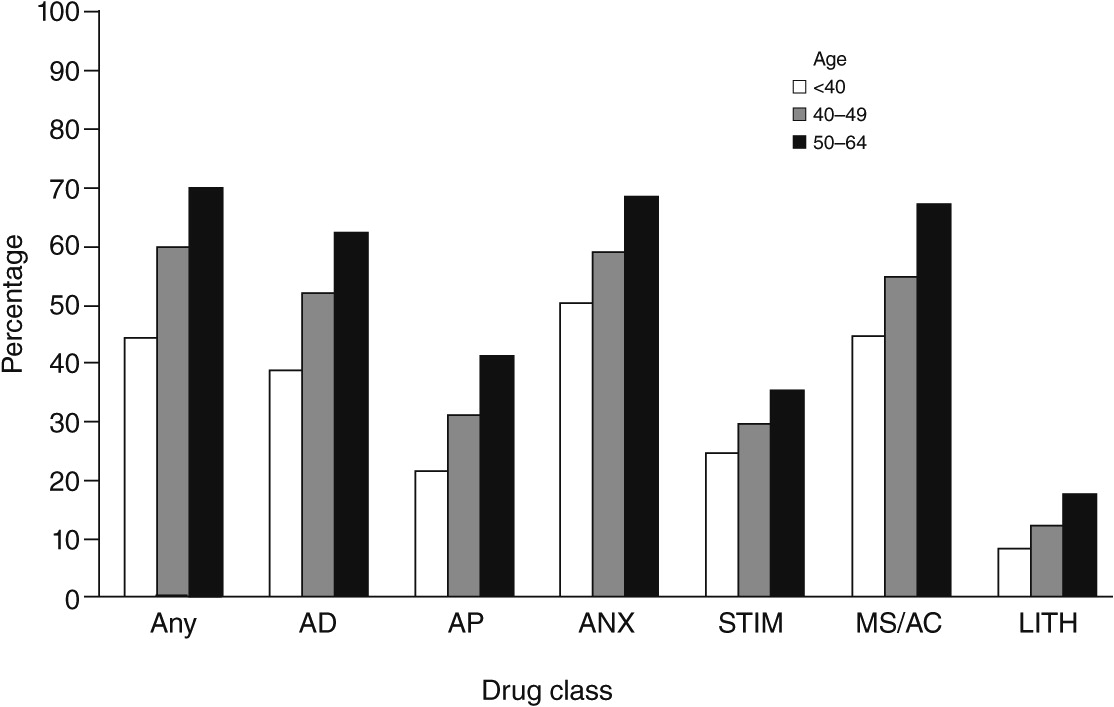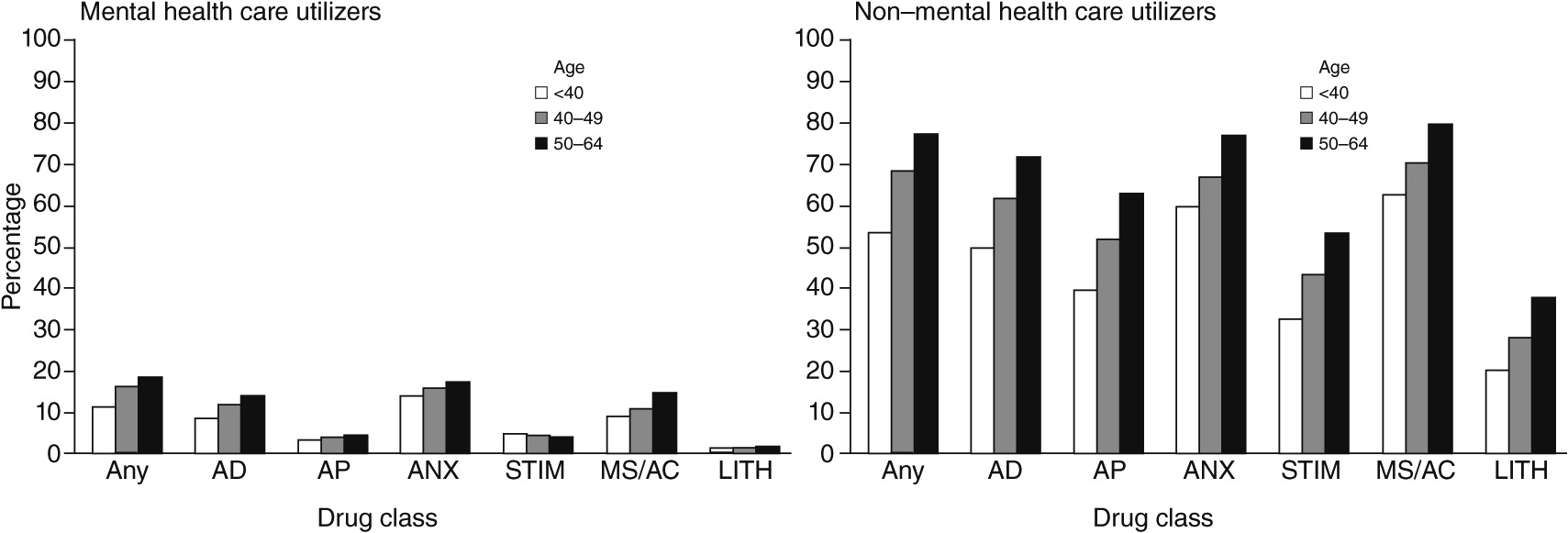Prescribing of Psychotropic Medications to Patients Without a Psychiatric Diagnosis
Abstract
Objective
Methods
Results
Conclusions
Methods
Sample and data sources
Measures
Analyses
Results
| Total(N=5,132,789) | Psychiatricdiagnosis(N=2,147,236) | No psychiatricdiagnosis(N=2,985,553) | ||||
|---|---|---|---|---|---|---|
| Characteristic | N | % | N | % | N | % |
| Age | ||||||
| <40 | 1,875,509 | 37 | 1,044,152 | 49 | 831,357 | 28 |
| 40–49 | 1,184,387 | 23 | 475,732 | 22 | 708,655 | 24 |
| 50–64 | 2,072,893 | 40 | 627,352 | 29 | 1,445,541 | 48 |
| Gender | ||||||
| Female | 3,306,525 | 64 | 1,341,723 | 63 | 1,964,802 | 66 |
| Male | 1,826,264 | 36 | 805,512 | 38 | 1,020,751 | 34 |
| Mental health care utilizera | 857,621 | 17 | 736,296 | 34 | 121,325 | 4 |
| Psychiatricdiagnosis | No psychiatricdiagnosis | ||||
|---|---|---|---|---|---|
| Utilization and prescription class | Total | N | % | N | % |
| All individuals | |||||
| Any psychotropic | 5,132,789 | 2,147,236 | 42 | 2,985,553 | 58 |
| Antidepressants | 3,181,968 | 1,522,740 | 48 | 1,659,228 | 52 |
| Antipsychotics | 378,280 | 262,072 | 69 | 116,208 | 31 |
| Anxiolytics | 2,372,883 | 927,018 | 39 | 1,445,865 | 61 |
| Stimulants | 549,509 | 404,600 | 74 | 144,909 | 26 |
| Anticonvulsant mood stabilizers | 576,635 | 244,977 | 42 | 331,658 | 58 |
| Lithium | 42,246 | 36,974 | 88 | 5,272 | 12 |
| Mental health care utilizersa | |||||
| Any psychotropic | 857,621 | 736,296 | 86 | 121,325 | 14 |
| Antidepressants | 627,175 | 559,290 | 89 | 67,885 | 11 |
| Antipsychotics | 161,817 | 156,477 | 97 | 5,340 | 3 |
| Anxiolytics | 383,950 | 324,693 | 85 | 59,257 | 15 |
| Stimulants | 160,124 | 153,653 | 96 | 6,471 | 4 |
| Anticonvulsant mood stabilizers | 141,777 | 126,054 | 89 | 15,723 | 11 |
| Lithium | 24,439 | 24,235 | 99 | 204 | 1 |
| Non–mental health care utilizers | |||||
| Any psychotropic | 4,275,168 | 1,410,940 | 33 | 2,864,228 | 67 |
| Antidepressants | 2,554,793 | 963,450 | 38 | 1,591,343 | 62 |
| Antipsychotics | 216,463 | 105,595 | 49 | 110,868 | 51 |
| Anxiolytics | 1,988,933 | 602,325 | 30 | 1,386,608 | 70 |
| Stimulants | 389,385 | 250,947 | 64 | 38,438 | 36 |
| Anticonvulsant mood stabilizers | 434,858 | 118,923 | 27 | 315,935 | 73 |
| Lithium | 17,807 | 12,739 | 72 | 5,068 | 28 |


| Characteristic | Wald chi square | OR | 95% CI | p |
|---|---|---|---|---|
| Age (reference: <40) | ||||
| 40–49 | 51,320 | 1.81 | 1.80–1.82 | <.001 |
| 50–64 | 194,469 | 2.87 | 2.86–2.88 | <.001 |
| Female (reference: male) | 3,654 | 1.14 | 1.13–1.14 | <.001 |
| Charlson Comorbidity Index | 23,766 | 1.19 | 1.19–1.20 | <.001 |
| Any medical indication for use | 6,200 | 1.19 | .1.19–1.20 | <.001 |
| Mental health care utilizera | 493,534 | .10 | .09–.10 | <.001 |
| Clinical encounters (N) | 72,207 | .98 | .98–.98 | <.001 |
Discussion
Conclusions
Acknowledgments and disclosures
References
Information & Authors
Information
Published In

Cover:
History
Authors
Metrics & Citations
Metrics
Citations
Export Citations
If you have the appropriate software installed, you can download article citation data to the citation manager of your choice. Simply select your manager software from the list below and click Download.
For more information or tips please see 'Downloading to a citation manager' in the Help menu.
View Options
View options
PDF/EPUB
View PDF/EPUBLogin options
Already a subscriber? Access your subscription through your login credentials or your institution for full access to this article.
Personal login Institutional Login Open Athens loginNot a subscriber?
PsychiatryOnline subscription options offer access to the DSM-5-TR® library, books, journals, CME, and patient resources. This all-in-one virtual library provides psychiatrists and mental health professionals with key resources for diagnosis, treatment, research, and professional development.
Need more help? PsychiatryOnline Customer Service may be reached by emailing [email protected] or by calling 800-368-5777 (in the U.S.) or 703-907-7322 (outside the U.S.).
